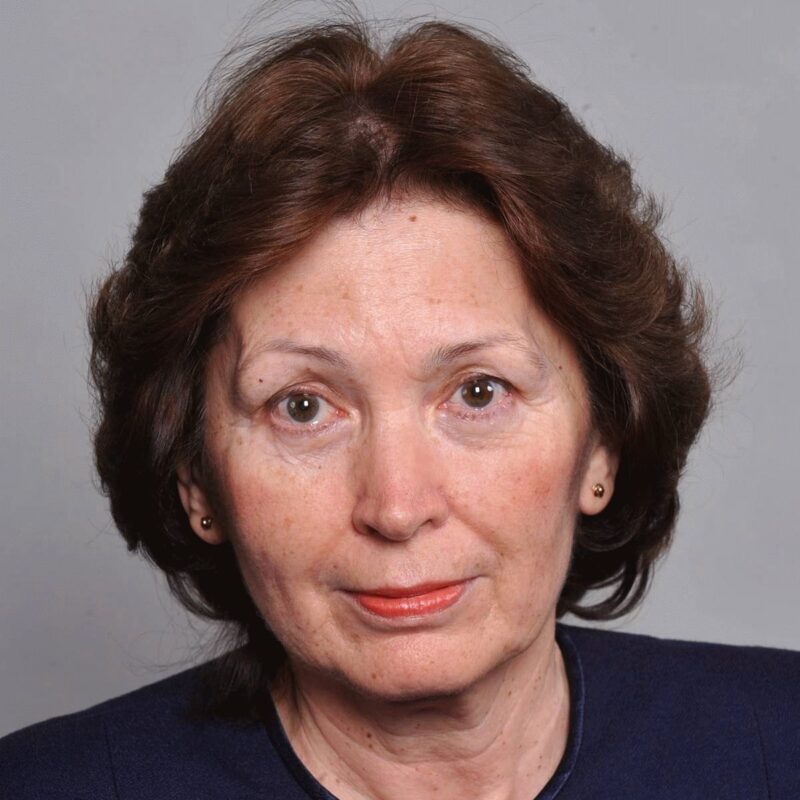
Katalin É. KISS
member of the Hungarian Academy of Sciences
Institute for Historical and Uralic Linguistics
Contact
103
+36 (1) 3429372 / 6032
Contact
103
+36 (1) 3429372 / 6032
Katalin É. KISS•Publications
Katalin É. KISS•Downloads
A szibériai kapcsolat – avagy miért nem tárgyasan ragozzuk az igét 1. és 2. személyű tárgy esetén. Magyar Nyelvjárások 41. (2003)
Gyuris Beátával: Apparent scope inversion under the rise fall contour. Acta Linguistica Hungarica 50: 371-404. (2003)
Parallel strategies of verbal complex formation in West-Germanic and Hungarian. In: É. Kiss K.és H. van Riemsdijk (szerk.): The Verbal Complex. A Study of Hungarian, German, and Dutch. John Benjamins, Amsterdam, 335-358. (2004)
Event types and discourse linking in Hungarian. Linguistics 43, 131-154. (2005)
The inverse agreement constraint in Hungarian – a relic of a Uralic–Siberian Sprachbund? In: Hans Broekhuis (szerk.) A Festschrift for Henk van Riemsdijk. John Benjamins, Amsterdam.(2005)
Focussing as predication. In: Valéria Molnar és Susanne Winkler (szerk.), The Architecture of Focus, Mouton de Gruyter, Berlin. (2006)
The function and the syntax of the verbal particle. In: É. Kiss K. (szerk.) Event structure and the Left Periphery. Studies in Natural Language and Linguistic Theory. Springer, Dordrecht. (2006)
From the grammaticalization of viewpoint aspect to the grammaticalization of situation aspect. In: É. Kiss K. (szerk.) Event structure and the Left Periphery. Studies in Natural Language and Linguistic Theory.Springer, Dordrecht. (2006)
Apparent or real? On the complementary distribution of identificational focus and the verbal particle. In: É. Kiss K. (szerk.) Event structure and the Left Periphery, 201-225. Studies in Natural Language and Linguistic Theory. Springer, Dordrecht. (2006)
Substitution or adjunction? Quantifiers and adverbials in the Hungarian sentence (2008) Lingua 1553
Syntactic, semantic and prosodic factors determining the position of adverbial adjuncts. 2009. In: É., Kiss (ed.) Adverbs and adverbial adjuncts at the interfaces. John Benjamins.
Deriving the properties of structural focus (2009) Proceedings of CIL 18)
Is free postverbal order in Hungarian a syntactic or a PF phenomenon? (2009) in: The Sound Pattern of Syntax, ed. by Nomi Erteschik-Shir and Lisa Rochman, Oxford University Press
Quantification in negative sentences (2009, to appear in Approaches to Hungarian 11)
Nekem el kell menni/el kell mennem/el kell, hogy menjek/el kell menjek/el kellek menni (2009, to appear in É. Kiss – Hegedűs: nyelvelmélet és dialektológia, PPKE)
The structure of the Hungarian VP revisited. In: Ch. Pinon (szerk.), Approaches to Hungarian 10. Akadémiai Kiadó, Budapest. (megjelenés alatt)
A nyelvészet mint természettudomány. Magyar Tudomány. (megjelenés alatt)
Jól megoldottuk? Rosszul oldottuk meg? Az összefoglaló és a kirekesztő kifejezést tartalmazó mondatok szórendjének magyarázata. Magyar Nyelv (megjelenés alatt)
Az ige utáni szabad szórend magyarázata. Nyelvtudományi Közlemények (megjelenés alatt)
Free word order, (non-)configurationality, and phases (kézirat)
Érvek és ellenérvek a fókusz [+kimerítő] jegyével kapcsolatban. (kézirat)
Structural focus and exhaustivity 2008.
A Jókai-kódex tagadó szerkezetei
A sem szinkrón és diakrón szerepéről
Valószínűleg, hogy román kontaktushatás
Agreement with coordinate phrases: morphosyntactic versus semantic identity
K. É.Kiss, Mátyás Gerőcs, Tamás Zétényi: The linguistic roots of multiplication
K. É.Kiss, Mátyás Gerőcs, Tamás Zétényi: The interaction of grammatical and visual information in preschoolers’ understanding of doubly quantified sentences, BCCCD2013
Ways of Licensing external possessors: preliminary version of Ways of licensing Hungarian external possessors. Acta Linguistica Hungarica Vol. 61 (2014) 1, 45-68.
Grammaticalized Backgrounding: preliminary version of Grammaticalized backgrounding. In: J. Brandtler, D. Hakansson, S. Huber, E. Klingvall: Discourse and Grammar. Lund University.
Katalin É. Kiss – Lilla Pintér: Identificational focus revisited. Paper presented at CL50 (the 50th anniversary meeting of the Chicago Linguistic Society) in May, 2014.
Katalin É. Kiss: From Proto-Hungarian SOV to Old Hungarian Top Foc V X. Diachronica Volume 30, Issue 2, 2013, pp. 202 –231.
Katalin É. Kiss: Accusative or possessive? The suffix of pronominal objects in Ob-Ugric (2020)